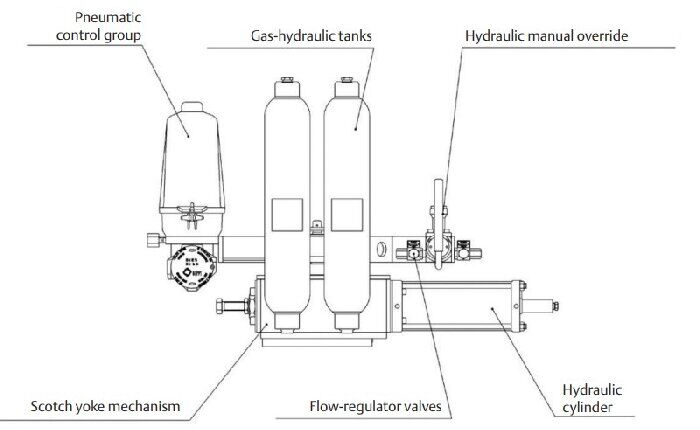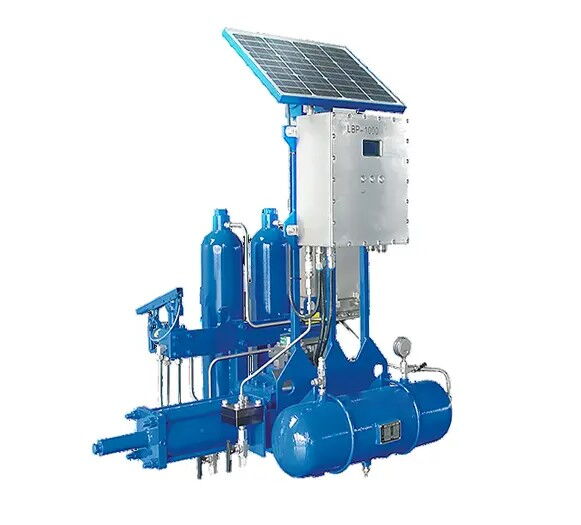Gas-Over-Oil Actuators: Efficient Valve Control Solutions
On this page
In industrial automation and high-demand environments, the ability to precisely control valves is crucial. The gas-over-oil actuators, with their unique self-powered design and efficient pneumatic-hydraulic systems, achieve reliable valve control using the pressure of pipeline natural gas. This gas-over-oil actuator not only simplifies traditional valve control systems but also demonstrates excellent environmental adaptability, making it an indispensable piece of equipment in industries such as oil and gas.
The core of the gas-over-oil actuator lies in its efficient pneumatic-hydraulic system. The operational process can be broken down into several steps.
Natural gas, used as the power source, is initially filtered and processed. It is then delivered directly to the gas storage tank and high-pressure pneumatic control valve set without further pressure reduction. This design simplifies the system structure and enhances operational stability.
Upon activation of the control signal, the high-pressure controlled gas is directed into the gas/oil circuit. The gas is converted into hydraulic power through the gas-over-oil conversion unit, based on the gas-oil synchronization principle, achieving smooth and precise transmission.
Liquid medium is transmitted through the equal pressure transfer principle, applying gas-oil synchronized drive to the hydraulic cylinder of the valve drive device. This mechanism ensures precise valve control, accommodating various complex operational requirements.
Through these steps, the gas-over-oil actuator can perform valve opening and closing operations using the pipeline's own gas pressure without additional power supply, greatly enhancing the system's independence and reliability.
The components of the gas-over-oil actuator and their functions are as follows.

Directly connected to the valve, responsible for receiving hydraulic power and outputting the required driving torque. This part ensures stable operation and reliability of the valve.
This Includes the gas storage tank and gas-oil tank, responsible for converting gas source power into hydraulic power. The design of this unit is based on high-pressure working principles, ensuring high efficiency and stability of the hydraulic system.
This unit controls the opening and closing of the gas-oil circuit to achieve various valve switching methods. This unit provides flexible operating modes to meet control needs under different conditions.
It monitors pipeline pressure parameters in real-time and performs automatic cut-off operations in emergencies. It also features a human-machine interface and data recording functions, enhancing operational convenience and maintenance efficiency.
The Emergency Shutdown (ESD) function protects the system during emergencies. A single ESD function involves emergency actions of the equipment itself, while the ESD interlock function provides comprehensive protection within the system, ensuring overall system safety.
The design of the gas-over-oil actuator aims to provide efficient and reliable valve control. Its basic functions and control methods are as follows.
Valve Switching: The actuator precisely controls the opening and closing of the valve through a gas-oil synchronized transmission mechanism. It can handle various fluid control tasks, including liquids, gases, and mixed media.
Remote Valve Switching: Supports remote operation, integrating valve control into automation systems for ease of operation and monitoring.
Pipe Rupture Automatic Protection (Locking Position): Automatically locks the valve in the event of pipeline rupture or major failure to prevent further system damage, enhancing system safety.
ESD Emergency Shutdown (Locking Reset): In emergency situations, the system can automatically perform emergency shutdown operations and lock the reset valve, ensuring rapid restoration to a safe state.
Manual Operation: In the absence or insufficiency of the power gas source, users can manually operate the valve using a local hydraulic pump, ensuring operational flexibility in the event of gas source failure.
Pneumatic Switching: When the power gas source is restored and meets requirements, the actuator can automatically switch the valve pneumatically, resuming normal operation.
Automatic Switching: The gas-over-oil actuator can automatically perform valve switching when pipeline pressure or pressure drop rate exceeds the set values and meets valve action conditions, enhancing the system's adaptability and response speed.
The proper operation of the gas-over-oil actuator requires the following conditions.
A stable 24VDC power supply is needed to ensure the normal operation of the electronic control unit and other electrical components, guaranteeing system stability and reliability.
A stable power gas source must be provided to ensure efficient operation of the pneumatic-hydraulic system. Stable gas source is key to ensuring the actuator functions correctly.
With its unique working principle and comprehensive functionality, the gas-over-oil actuator demonstrates exceptional performance and reliability in demanding industrial environments. Its efficient control using the pipeline's medium pressure not only enhances the system's autonomy and safety but also optimizes overall operational efficiency. As a key component in high-demand applications, the gas-over-oil actuator undoubtedly provides a stable and reliable solution for modern industrial systems.

